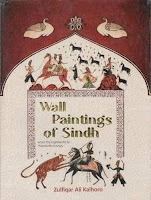Secret treasures
 In India, Sindhis are most often seen as a
mercantile community – hardworking and enterprising, but almost entirely
focussed on material gain and pursuits, with limited interest in art and
culture. Sindh itself, the ancestral homeland which the Hindus left after
Partition took place in 1947 and to which they have almost no access today, is
seen as a hot and dusty place of limited opportunity. So this book is a real
eye-opener which showcases a very unexpected dimension for Indian Sindhis to
understand something about their lost heritage.
In India, Sindhis are most often seen as a
mercantile community – hardworking and enterprising, but almost entirely
focussed on material gain and pursuits, with limited interest in art and
culture. Sindh itself, the ancestral homeland which the Hindus left after
Partition took place in 1947 and to which they have almost no access today, is
seen as a hot and dusty place of limited opportunity. So this book is a real
eye-opener which showcases a very unexpected dimension for Indian Sindhis to
understand something about their lost heritage.
In 1998, early in anthropologist Zulfiqar
Ali Kalhoro’s career, a field visit took him to the necropolis of Mian Nasir
Muhammad Kalhoro, where he saw many beautiful paintings on the exterior and
interior walls of its monuments. He could see that they were crumbling and in
urgent need of restoration. Feeling overwhelmed by the beauty of the art around
him, feeling equally disturbed that it would all soon be lost, Zulfiqar
resolved that he was going to travel all across Sindh to seek out every other
similar site he could find, and record whatever he saw in them. This book is a
result of many fulfilling journeys the author made over more than 20 years, to
do so – and a great gift to people who are interested in the history of art,
and in particular the history of the art of Sindh.
What I learnt from this book is that Sindh
is strewn with monuments of many kinds and these include tombs, places of
worship, and palaces. Most of these are filled with works of art, and besides
architectural flourishes, ceramic embellishments and tiling, many of the walls
are covered with paintings too.
In many places, Zulfiqar Ali Kalhoro noticed that in the process of maintenance of the tombs by their followers, they were whitewashed on the inside, and the paintings were damaged. For example, in the tomb of Mian Yar Muhammad Kalhoro in Khudabad, Zulfiqar found it all whitewashed except for some paintings which may have required too much effort to reach. From these traces, he deduces that
“the whole interior of the tomb was adorned with stylized flower vases, fruit dishes and a variety of flowers covering every panel, soffit, niche, squinch and arch recess of the tomb.”
His research indicates that the art was a
tradition of long-standing, but very little of what was created before the
seventeenth century remains and this book largely covers art of the Kalhora,
Talpur and British periods of Sindh’s history. Many of the previous era, glimpses
of which sometimes pop up in historical records, no longer exist.
Royal tombs, Zulfiqar points out, are not embellished with figural motifs, except for birds. They carry gilded Quranic verses in striking calligraphy; traditional geometric patterns; and floral, vegetal, plant and tree motifs. The lily flower, Zulfiqar points out, is a favourite motif of the Kalhora artists in both paintings and glazed tiles. Zulfiqar also explains the symbolism of other favoured motifs such as the cypress tree, and varieties of birds and flowers. Monuments of other rulers and saints, however, carry all kinds of figural depictions including scenes of a bird feeding its offspring, rooster fight, mourning scene in a tomb, action-packed animal fight scenes, hunting scenes and battle scenes, as well as representations of cultural activities, such as dance, music and sports, and many romantic folk scenes. In all, they provide a rich illustration of the social and political life of Sindh. There are even tombs which also show domestic activities such as dancing, cooking and churning, such as the tomb of Othwal Faqir, located south of Mian Nasir Muhammad Kalhoro’s shrine. In fact, locations of each monument have been meticulously provided – a poignant resource for the many who may want to visit but are unlikely to ever be able to do so.
Most of these art treasures, Zulfiqar Ali
Kalhoro reports, are in sad repair. In the twenty years of his quest, he has
seen them decay before his eyes, under the ravages of extreme climate. It is
sad to think that in the decades to come, most will vanish, unrestored, and
live on only in the pages of this book. It’s not just the government which is
responsible for the neglect – but who can blame needy peasants who till the protected
land close the beautiful monuments to fulfil their simple needs?
What I learnt from this book moved me deeply. What I saw and read made me feel connected with a precious and distinctive heritage which has been frittered away and is only saved from complete obliteration by books like this one.








